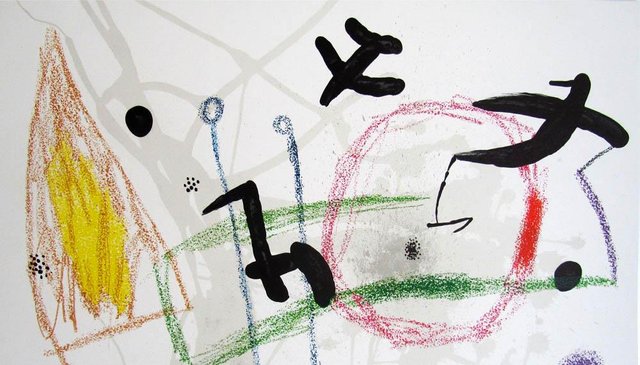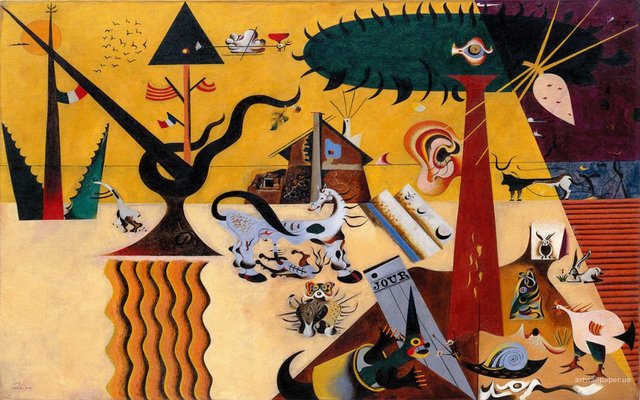🎨 Artistic space #19 - Keys to understanding Joan Miró's language
Keys to understanding Joan Miró's language
Joan Miró explained that his work was like "an imagination of the world of appearances". Starting from real things, he transformed them into a new language, as if it were an epiphany of a world that until then had been hidden behind appearances. Miró was not an abstract painter, he was a visionary who revealed inner universes, beyond the visible. His particular language, between grotesque and naïf, which has given him a reputation as frivolous and childish, is the expression of another reality, an essential and invisible reality that exists in everyday life. Miró represents the will to look beyond the surface.

The effect of hunger
Miró was nourished by Post-Impressionism, Cubism, and Fauvism. Although he participated in exhibitions with André Breton's group, he was not an orthodox surrealist. "A Spaniard doesn't need to be a surrealist, it's irrational enough," he said. I was interested in the idea of peinture-poésie - painting as visual poetry - but the narrative aspect of surrealism, the little stories, didn't matter to me.

When Pablo Picasso told him not to move from Paris if he wanted to be a painter, Miró did not hesitate. He rented an atelier there, but for the first few years he could barely afford a meal a week: he lived on figs and chewing gum. In those days hunger gave me hallucinations, and hallucinations gave me ideas for my paintings," he recalled of his Parisian beginnings.
Less is more
Miró created his own iconography, an alphabet that retakes symbols and figures from his early production and is included with changes in his new works.
He sought to obtain the maximum of intensity with the minimum of resources: his characters, he said, suffered the same synthesis as the colors of his paintings. For him, thus simplified they were more human and vivid than if they had been represented with all the details.

I decided to dedicate myself to the secret life of things and little by little I suppressed all exterior reality to arrive at the sign that is an ideogram -he pointed out-. This understanding of an interior life of things is found in the oriental culture. In Japan, I have felt at home.
Its cosmic universe includes eyes, which allude to the power of sight and gaze, stars, biomorphic forms, birds, stars, women-birds, and the sun. The parenthesis is a sign that uses as a barrier that blocks the leakage of energy. A line and a small oval are enough to represent a dragonfly in flight.
Between heaven and earth
With characters and objects from a magical galaxy, he painted between 1940 and 1941 the first Constellations in Varengeville, a French town he had reached escaping the Second World War. Inspired by the sky of the Norman coast, they are made on wet and wrinkled paper.

Miró always felt linked to the rural world. His father was from Cornudella and his family had a field in Montroig, where he spent the summer. The relationship with the land is key from his famous painting The Farmhouse, with a telluric imprint, whose representation and symbols would be modified. The figures with enormous feet that inhabit many of his compositions symbolize the force that emanates from the earth and nourishes man.

In his work, the axis was placed in the forces of nature. "Each particle of dust has a marvelous soul, but to understand it we need to rediscover the magical and religious significance of all things, the same that they had for primitive man," said the artist.
Voracious expirementer
In an effort to reach the widest possible audience, Miró designed costumes for choreography, record covers, plates, pots, tiles, murals, ceramic flooring and posters for UNESCO and Amnesty International campaigns.

On the other hand, words and numbers dilute in his work the idea of painting as a space of traditional representation. He appealed to poetic titles - Poem to the glory of the sparkles, Woman in trance by the escape of the shooting stars and The poppy dance are some of the works that will be exhibited at the MNBA - and he never stopped expanding his language.

In the 1960s he resumed college and assembly of objects from the 1920s and 1930s to make sculptures cast in bronze, to which he incorporated modeling. With objects he collected, he made his sculptures "in a very lively way, in contact with the elements of nature" in order to create, according to him, "a truly phantasmagorical world of living monsters".
He appealed to new formats and techniques ranging from mosaics, sculptures, tapestries and monumental public sculptures of fibrocement to ceramics for the public space and large collages with pieces of wire and stones.

Pure color fields and thick black strokes prevail in his compositions: he eliminated the horizon line, focusing on primary shapes and colors.
New realities
Although he had a taciturn character and believed that life was absurd, he found in the art the way to face a tragic destiny.
"The play of lines and colors, if it does not undress the drama of the creator, is nothing more than a bourgeois entertainment," he said. Forms must reveal the movement of a soul that wants to escape from present reality, particularly vulgar, in order to approach new realities. And to offer men a possibility of elevation: to discover a world inhabitable by something more than rottenness to sweep away."

Thank you for reading 😊


If you liked reading this article, feel free to FOLLOW ME, UPVOTE and RESTEEM! It's always appreciated =D. Thank you all for your support and see you soon for the news flamingirl's adventures!


wow really awesome paintings.. great art by Joan Miró ..
Thanks for sharing this beautiful post..
Thank you so much for your nice comment my dear Steemian friend!
Have a nice Monday! =)